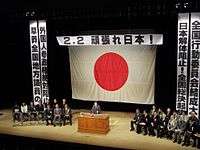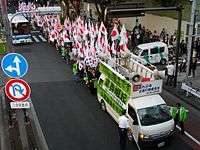Ganbare Nippon

Ganbare Nippon! Zenkoku Kōdō Iinkai (頑張れ日本!全国行動委員会) (literally: Hang In, Japan! National Action Committee), usually abbreviated to Ganbare Nippon (頑張れ日本), is a Japanese right-wing group founded on February 2, 2010.[1] One of the founders was right-wing filmmaker and playwright Satoru Mizushima.[2]
The inaugural chair was former Chief of Staff of Air Self-Defense Force Toshio Tamogami.[3][4] As of March 2015 he was no longer the head of the group.[5]
Activities

Ganbare Nippon has participated in a number of demonstrations and actions concerning right-wing issues.
Protests against Democratic Party of Japan
In January 2011 the group organized a protest against the ruling Democratic Party of Japan. Around 1900 people joined the event calling on the DPJ to step down. Several lawmakers attended, including Takeo Hiranuma, head of the Sunrise Party of Japan.[6]
Protest against Yomiuri Shimbun
In January 2012 it protested against the conservative Yomiuri Shimbun newspaper. The Yomiuri had editorialized in favor of the Imperial succession being opened to female members of the Imperial family.[7]
Senkaku Islands flag-raising
Following a visit to the disputed Senkaku Islands by a group of 14 Hong Kong pro-China activists, five of whom went ashore, who were deported by Japan without being charged. Ganbare Nippon arranged an unauthorized visit to the Senkakus.[8]
About 150 people on about 20 boats left Ishigaki Island in Okinawa Prefecture and sailed to the island to hold a service for Japanese who died near the Senkakus during World War Two.[9]
After the service ten people swam ashore, five of those who swam ashore were from the organizing group and five were local assembly members from Tokyo, Hyōgo Prefecture, Suginami and Arakawa Wards in Tokyo, and Toride in Ibaraki Prefecture. They raised several Hinomaru flags after landing.[10][11] Tamogami said: "With the Chinese activists just having landed, this is a way of telling them not to mess around. We hope to convey to both China and to Japanese people, through the media, or whatever means, that the Senkakus are our territory.”[12] The flotilla arrival at the archipelago set off anti-Japanese rallies in more than 25 Chinese cities,[13][14] Chinese protestors overturned Japanese-branded cars and smashed windows of Japanese-themed businesses.[15][16]
Protest against Chinese protests
Japan formally nationalized the three Senkaku islands that had been held in the ownership of Kunioki Kurihara.[17][18] Substantial Chinese protests followed, and on 18 September 2012, Ganbare Nippon organized an anti-Chinese counterprotest in Tokyo which was attended by about 50 people.[19]
Protest against homosexuality
On 10 March 2015, Ganbare Nippon organized a protest in Shibuya against homosexuality, with slogans such as "Normal love is between a man and a woman" and "LGBT ruins society".[20]
References
- ↑ Lee, Elaine. "Japan nationalists return after nearing islands disputed with China". MSN.News. Retrieved 19 October 2013.
- ↑ The Wall Street Journal Japan's Nationalist Movement Strengthens August 14, 2012 Retrieved on August 20, 2012
- ↑ The Japan Times Conservatives rally against DPJ January 30, 2011 Retrieved on August 20, 2012
- ↑ Reuters Japan nationalist dreams of new patriotic party July 27, 2012 Retrieved on August 20, 2012
- ↑ Japan Times Conservatives lash out at Shibuya Ward initiative to recognize same-sex relationships Mar 12, 2015 Retrieved March 15, 2015
- ↑ The Japan Times Conservatives rally against DPJ January 30, 2011 Retrieved on August 21, 2012
- ↑ Shingetsu News Conservative Protest at the Yomiuri Shinbun January 20, 2012 Retrieved on August 20, 2012
- ↑ Japanese Land On Disputed Islands As Protests Fuel China Tension August 20, 2012 Retrieved on August 20, 2012
- ↑ The Daily Yomiuri Japanese land on Senkakus / 10 citizens, including assembly members, raise natl flags on isle 20 August, 2012 Retrieved on August 21, 2012
- ↑ The Daily Yomiuri Tokyo govt applies to land on Senkaku island / Police question Senkaku visitors August 21, 2012 Retrieved on August 21, 2012
- ↑ Time magazine Activists Up Ante in China, Japan Isle Dispute August 19, 2012 Retrieved on August 20, 2012
- ↑ Euronews Tit-for-tat landings in Japan-China island row August 19, 2012 Retrieved on August 20, 2012
- ↑ The Daily Yomiuri Anniversary events at risk over isle feud August 21, 2012 Retrieved on August 21, 2012
- ↑ NHK Anti-Japan protest spreading over China August 19, 2012 Retrieved on August 20, 2012
- ↑ The Washington Post Japanese activists land, raise flags on disputed island, provoking Chinese protests, 18 August 2012 Retrieved on August 18, 2012.
- ↑ "Chinese stage anti-Japan rallies over Senkakus | The Japan Times Online". Japantimes.co.jp. Retrieved 2012-08-20.
- ↑ "Monday, September 10, 2012 (PM), Press Conference by the Chief Cabinet Secretary (Excerpt)". Tokyo: Kantei (Cabinet Secretariat), Cabinet Public Relations Office, Japan. 2012-09-10(PM). Retrieved 2012-09-16.
CHIEF CABINET SECRETARY FUJIMURA: 1.There is no doubt that the Senkaku Islands are clearly an inherent territory of Japan, in light of historical facts and based upon international law......
Check date values in:|date=(help) - ↑ "Japan buys three of Senkaku Islands from owner; Mainichi Shimbun". www.mainichi.jp. Retrieved 2012-09-11.
- ↑ Warnock, Eleanor (September 18, 2012). "Small Turnout for Anti-China Protest in Tokyo". The Wall Street Journal.
- ↑ "Excite".
External links
- Official webpage (Japanese)